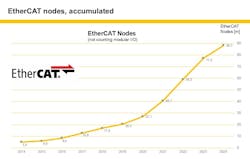EtherCAT Technology Group adds EtherCAT users
The EtherCAT Technology Group (ETG) reports that around 88 million EtherCAT nodes are active in the field, adding another 11 million nodes in 2024.
These node figures are based on actual chip sales, which are reported by the chip manufacturers to Beckhoff Automation, the inventor of EtherCAT technology. “They have no interest in exaggerating these figures, as this would entail additional costs for them,” explains Martin Rostan, executive director of the ETG. With EtherCAT, the technology license is included directly in the chip, so there are no additional license fees for device manufacturers and users. Beckhoff uses the license revenue to finance the activities of the EtherCAT Technology Group and thus the ecosystem surrounding the technology.
The number of field programmable gate array (FPGA)-based EtherCAT devices, which can only be estimated, remains an uncertain factor when calculating the number of nodes. “We assume that these implementations make up around 10% of the total number. The figure is probably even higher, but we are being deliberately conservative in our estimate,” Rostan says. Multi-protocol chips are also taken into account, but only proportionally in relation to the market share of EtherCAT at the respective manufacturers.
The EtherCAT Technology Group is an organization that brings together user companies from various industries and automation suppliers to support, promote and advance the EtherCAT technology. ETG was founded in November 2003 and has more than 8,100 members from 76 countries.

